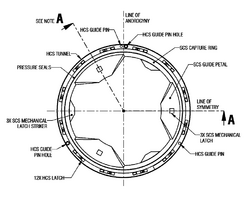International Docking System Standard
Topic: Engineering
 From HandWiki - Reading time: 4 min
From HandWiki - Reading time: 4 min

The International Docking System Standard (IDSS) is an international standard for spacecraft docking adapters. It was created by the International Space Station Multilateral Coordination Board, on behalf of the International Space Station partner organizations; NASA, Roscosmos, JAXA, ESA, and the Canadian Space Agency.
The IDSS was originally formulated in 2010.[1] The plan is for all cooperating agencies to make their future docking systems IDSS compatible.[citation needed]
Design
The IDSS docking mechanism can be androgynous, uses low impact technology, and allows both docking and berthing.[2] It supports both autonomous and piloted docking and features pyrotechnics for contingency undocking. Once mated, the IDSS interface can transfer power, data, commands, air, communication, and in future implementations, will be able to transfer water, fuel, oxidizer and pressurant as well.[3]
The passage for crew and cargo transfer has a diameter of 0.8 meters (31 in).[4]
The IDSS has a 2-phase docking procedure consisting of a soft capture and hard capture system.
Active and passive docking roles
During a docking maneuver, one vehicle assumes the "active" role and the other vehicle assumes the "passive" role. A particular IDSS port can be manufactured to be able to act in the active role, the passive role, or either role. If a port (e.g., the ones on the ISS) is passive-only, then the other spacecraft must implement the active role. If a port is active-only (e.g., the ports on Crew Dragon and Cargo Dragon, and Starliner), then the other spacecraft must implement the passive role. This means that spacecraft with active-only ports cannot dock with each other using these ports.[4]
Soft Capture System
The soft capture system (SCS) of the active docking system is extended while the passive system remains retracted. Each SCS includes 3 equally spaced petals around the docking ring. As the spacecraft approach each other, the petals on the SCS align the two docking rings and the two become mechanically latched. 6 servo-actuated legs then remove any relative motion and may begin to retract. The use of the SCS allows for 6 degrees of freedom, reducing the accuracy requirement of initial docking procedures.
Hard Capture System
Once soft capture is achieved, the hard capture system (HCS) can begin final structural mating. It consists of 12 pairs of mechanical hooks on both the passive and active port. Guide pins are used to ensure accurate alignment of the docking rings to properly allow the hooks to engage. Once the hooks are fully driven, the docking ports' electrical connectors can begin transferring data and the docking procedure is complete. [5]
Implementations
The NASA Docking System is NASA's implementation of the IDSS.[6] The International Docking Adapter (IDA) converts older Russian APAS-95 docking systems to the International Docking System Standard. IDA implements the passive IDSS role. NASA set June 2016 as the starting date to construct 4 of the NASA Docking System units for the Commercial Crew Development program.[7] Two International Docking Adapters were added to the International Space Station, and another was destroyed on ascent.[8] (As of September 2023) these ports have been used during nineteen SpaceX Dragon 2 missions and one Boeing Starliner mission.
Boeing Starliner uses the NASA Docking System version of IDSS, implementing the active role.
The ESA's International Berthing and Docking Mechanism is their IDSS compatible docking system.
Lunar Gateway will be assembled in lunar orbit from modules that connect to each other using IDSS ports. Visiting spacecraft (Orion, HLS, GLS) will connect to Gateway using IDSS ports.
In March 2020, Space.com reported that a Chinese crew capsule is possibly IDSS compatible.[9]
SpaceX designed and implemented an IDSS port for the Crew and Cargo Dragons.[10] The ports implement the active role.
References
- ↑ "New international standard for spacecraft docking". http://www.esa.int/Our_Activities/Human_Spaceflight/New_international_standard_for_spacecraft_docking. Retrieved 2015-11-21.
- ↑ NASA Docking System (NDS) Technical Integration Meeting (2010-11-17)
- ↑ Parma, George (2011-05-20). "Overview of the NASA Docking System and the International Docking System Standard". NASA. Archived from the original on 15 October 2011. https://web.archive.org/web/20111015075220/http://dockingstandard.nasa.gov/Documents/AIAA_ATS_NDS-IDSS_Overview_Draft1.pdf. Retrieved 11 April 2012.
- ↑ 4.0 4.1 "International Docking System Standard (IDSS) Interface Definitions Document (IDD) Revision D April 2015". ISS Multilateral Control Board. http://www.internationaldockingstandard.com/download/IDSS_IDD_Revision_D_043015.pdf. Retrieved October 31, 2015.
- ↑ "International Docking System Standard (IDSS) Interface Definition Document (IDD)". https://www.internationaldockingstandard.com/download/IDSS_IDD_Revision_E_TAGGED.pdf. Retrieved 7 June 2020.
- ↑ Garcia, Mark. "Meet the International Docking Adapter". http://www.nasa.gov/feature/meet-the-international-docking-adapter. Retrieved 2015-11-21.
- ↑ "Draft Request for Proposal, NNK14467515R, CCtCap". NASA. p. 8. http://prod.nais.nasa.gov/eps/eps_data/157250-DRAFT-001-001.pdf. Retrieved July 22, 2013.
- ↑ "Second docking adapter for commercial crew vehicles installed on International Space Station" (in en-US). https://social.techcrunch.com/2019/08/21/second-docking-adapter-for-commercial-crew-vehicles-installed-on-international-space-station/.
- ↑ Jones, Andrew (30 March 2020). "China's new crew spacecraft looks like it could dock with the International Space Station" (in en). https://www.space.com/china-new-spacecraft-dock-space-station.html.
- ↑ "Sealed with Care – A Q&A". NASA. August 3, 2020. https://www.nasa.gov/feature/glenn/2020/sealed-with-care-a-qa.
External links
- http://www.internationaldockingstandard.com/ (Website containing Revision E, October 2016)
 |
 KSF
KSF
